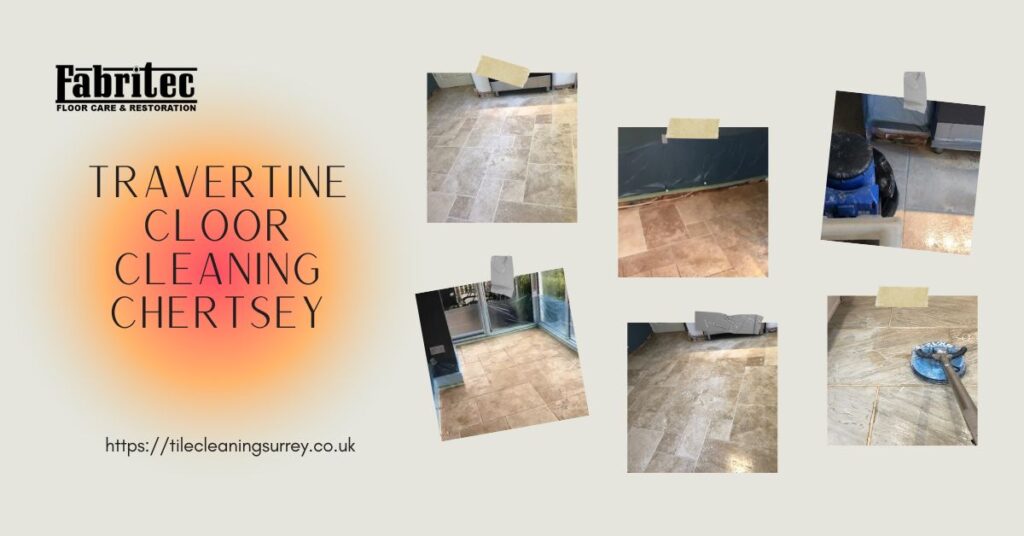
Unlocking the Secrets to Effective Care for Your Travertine Floors
Travertine floors are not only visually striking but also possess unique characteristics that necessitate proper care to maintain their captivating beauty. In our latest project, we tackled the challenge of revitalizing a heavily worn travertine floor in a residential setting located in Chertsey, Surrey. This in-depth case study will detail the precise techniques we employed to cleanse, repair, and seal the travertine flooring effectively. Our thorough approach ensured that the floor not only regained its original charm but also acquired enhanced durability, protecting it from future wear and tear. Regular travertine floor maintenance is essential; without it, homeowners risk facing significant deterioration over time.
Conducting a Comprehensive Assessment and Preparing the Space for Cleaning
During our initial evaluation, we observed salient signs of wear on the travertine floor, such as a considerable build-up of dirt in the grout lines, the presence of natural small holes typical of travertine, and minor cracks in several tiles. To ensure an effective cleaning operation, we began by removing all furniture from the area and performing a meticulous vacuuming to eliminate any loose debris and dust. This preparatory stage is crucial for creating a successful cleaning environment. Additionally, we set up protective sheeting around the area, covering adjacent surfaces like kitchen units and neighboring flooring. This precautionary step is vital for preventing any damage from cleaning solutions or equipment, thereby fostering a safe and efficient workspace. Properly executing floor preparation techniques significantly impacts the overall results of the restoration process.
Executing a Thorough Deep Cleaning Approach for Travertine Tiles
The cornerstone of revitalizing travertine lies in an extensive deep cleaning strategy. We initiated the process by applying a diluted, professional-grade travertine cleaner across the entire floor surface, ensuring we focused on the grout lines and particularly soiled areas. Allowing the cleaner to sit for roughly ten minutes effectively loosened embedded dirt and grime. We then employed a rotary scrubbing machine to agitate the cleaner into the tiles, successfully lifting the accumulated dirt and revealing a much cleaner surface. To complete the cleaning phase, we performed a pressure rinse—a critical step that eradicates any lingering cleaning slurry and debris. This rinse also removes any residual sealers, ensuring the surface is perfectly prepared for the following repair and sealing procedures. The importance of deep cleaning travertine cannot be overstated, as it lays the essential groundwork for a successful restoration.
Utilizing Professional Repair Methods to Address Travertine Damage
Upon concluding the cleaning process, we discovered several natural holes and minor cracks in the travertine tiles, which are common challenges associated with this stone type. To effectively address these issues, we implemented two targeted repair strategies:
Seamlessly Repairing Natural Holes to Enhance Visual Appeal:
We used premium beige fillers that perfectly matched the color of the existing tiles to fill the natural holes. This crucial step not only restored the uniform appearance of the floor but also minimized the potential for future dirt accumulation in these crevices, thus boosting the overall visual allure. A well-executed filling process is indispensable for maintaining the integrity of travertine tiles and prolonging their lifespan.
Expert Techniques for Repairing Cracks to Ensure Longevity
For the cracked tiles, we selected a robust resin grout that accommodates slight movement without the risk of further cracking. By meticulously color-matching the grout to the tiles, we ensured that the repairs were virtually invisible, maintaining the floor’s cohesive aesthetic. These expert repair techniques are vital in preserving the beauty and functionality of travertine surfaces, guaranteeing they remain both attractive and resilient for years to come.
Applying a Premium Sealant to Strengthen Your Travertine Floors
The sealing of the travertine floor marks the final and most critical step in the restoration process. Applying a sealant is essential for shielding the stone from stains, spills, and everyday wear, significantly extending the longevity of the floor. For this specific project, we opted for a high-solids, breathable sealer that penetrates the travertine while forming a strong protective barrier on the surface. Our client preferred a satin finish, which elegantly highlighted the natural beauty of the travertine without creating an overly glossy appearance. After the sealer was applied, we allowed it to cure for several hours, ensuring the floor was ready for regular use. The significance of sealing travertine floors cannot be overstated, as it is a fundamental aspect of preserving the beauty and integrity of the surface.
Establishing a Detailed Aftercare Routine for Lasting Results
To keep the travertine floor looking refreshed and vibrant, we provided our client with an extensive aftercare plan designed for regular implementation. This routine includes several essential practices:
- Utilize a pH-neutral cleaner specifically formulated for sealed natural stone, such as LTP Floorshine, to avoid damaging the protective layer.
- Regularly vacuum or dust the floor to eliminate dirt and debris that could scratch the surface.
- Quickly clean up any spills to prevent staining and maintain the floor’s pristine appearance.
- Reapply the sealer every 2 to 3 years, depending on foot traffic, to ensure ongoing protection and aesthetic appeal.
Maintaining a consistent aftercare routine is vital for ensuring the longevity and beauty of travertine flooring, allowing homeowners to enjoy their stunning floors for many years ahead.
Stunning Transformation: The Advantages of Professional Restoration Services
After completing the cleaning, repair, and sealing processes, the travertine floor at the Chertsey property underwent a remarkable transformation. The floor now radiates a renewed luster, showcasing clean grout lines and nearly invisible repaired cracks. The client expressed immense satisfaction with the results, and the floor is now well-protected against potential future damage, ensuring its beauty endures for many years to come. This project exemplifies the effectiveness of professional maintenance in preserving both the aesthetic appeal and functional longevity of travertine flooring. A delighted client remarked, “We couldn’t be happier with the results! Our travertine floor looks absolutely stunning—like it’s brand new again. The team was professional, thorough, and took great care to restore every detail. We’re thrilled with how well the repairs blend in, and the sealing has made cleaning so much easier. Highly recommend their service!”
Addressing Your Common Questions About Travertine Floor Care
How Often Should I Clean My Travertine Tiles?
Effectively maintaining travertine tiles necessitates regular cleaning, ideally once or twice a week, depending on the level of foot traffic in your home. Additionally, a thorough deep cleaning every six months is advisable to ensure the tiles retain their visual charm and longevity. Always select appropriate cleaners to safeguard your investment in flooring. The frequency of travertine tile cleaning is paramount for maintaining its enduring beauty and structural integrity.
Can I Use Vinegar to Clean Travertine Surfaces?
The use of vinegar on travertine surfaces is highly discouraged due to its acidic nature, which can damage both the stone and its protective seal. Instead, it is far more beneficial to utilize a pH-balanced cleaner specifically formulated for natural stone, which will help maintain the integrity and longevity of your travertine flooring. Understanding which products to avoid is essential for travertine surface preservation and ensuring the floors remain in excellent condition.
What Are Common Signs of Travertine Damage?
Common indicators of travertine damage include visible cracks, chips, discoloration, and uneven surfaces. Persistent stains or a dull appearance may also signify wear, necessitating immediate attention to uphold both the aesthetics and structural integrity of the flooring. Recognizing these signs early can facilitate timely intervention, ensuring the durability of travertine floors and preserving their beauty for the long term.
Is Travertine Suitable for Outdoor Use?
Indeed, travertine is highly suitable for outdoor applications due to its durability and natural slip resistance. However, proper sealing is essential to protect it from the elements and staining, ensuring its longevity and maintaining its visual appeal in outdoor settings. Understanding the suitability of travertine for outdoor environments can assist homeowners in making informed choices for their outdoor spaces.
How Can I Prevent Future Staining on Travertine?
To effectively prevent future staining on travertine, it is crucial to regularly apply a high-quality sealer, promptly clean any spills, and utilize pH-neutral cleaners. Moreover, maintaining a consistent cleaning routine will enhance the stone’s durability and visual appeal. Proactive measures are key to ensuring the long-term beauty of travertine surfaces and safeguarding your investment.
The post: Travertine Cleaning Chertsey was produced by Travertine Floor Cleaning Chertsey
The Article Cleaning and Sealing a Travertine Floor in Chertsey, Surrey appeared first on https://fabritec.org
The Article Travertine Floor Cleaning and Sealing in Chertsey Was Found On https://limitsofstrategy.com


Your insights on the intricacies of caring for travertine floors are particularly compelling, especially considering how easily such beautiful surfaces can lose their luster without proper maintenance. I recently undertook a similar project in my own home, where I discovered the enduring impact of neglecting regular care. It was revealing to see how just a little buildup of dirt and grime can obscure the natural patterns and colors inherent in the stone.